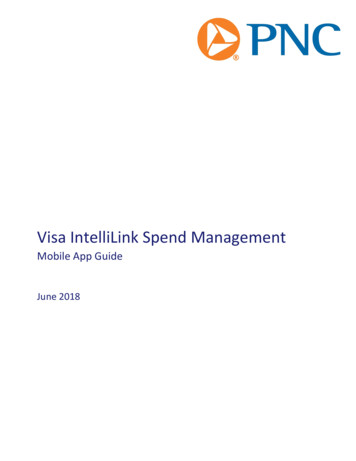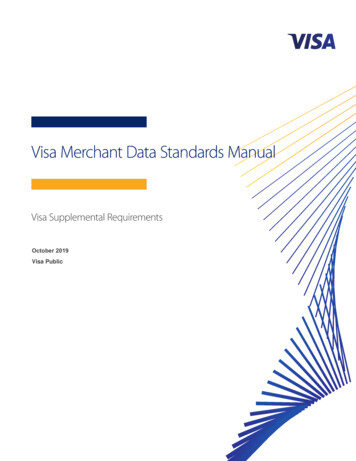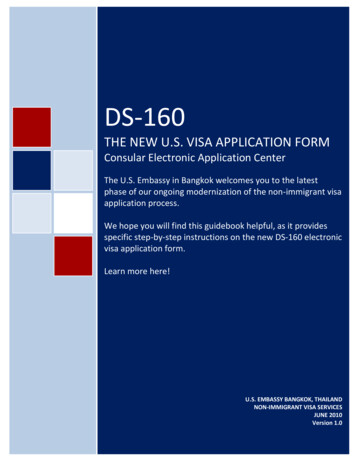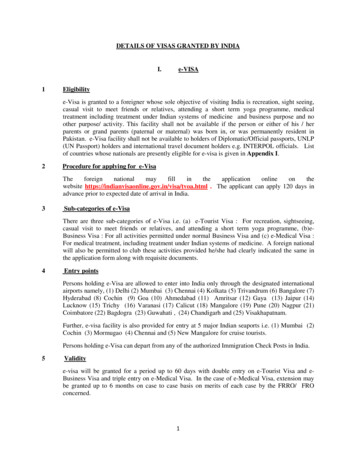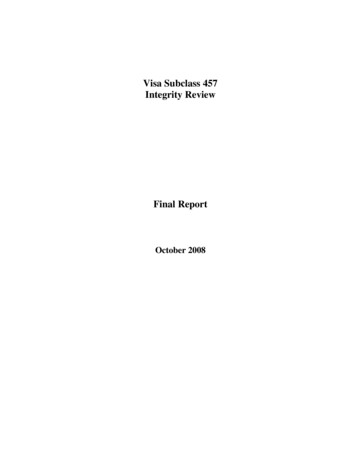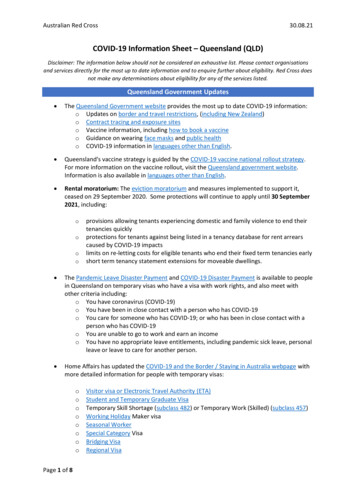
Transcription
Visa Inc.’s Response to the Reserve Bank ofAustralia’s Review of Retail PaymentsRegulation Issues Paper
Table of ContentsGroup Country Manager LetterOverview45Chapter 1: Strategic Issues in the Retail Payments System101.1 The Future Role of Cash1.2 The Future of the Cheques System1.3 Capabilities around the Management of Automated and Recurring Payments1.4 New Technologies and Entrants1.5 Resilience of the Retail Payments System1.6 Cross-Border Payments1.7 Regulatory Technology10111111131516Chapter 2: Competition in the Cards Market – Payment Economics172.1 Dual-Network Debit Cards and Merchant Choice Routing2.1.1 Introduction2.1.2 Consumer Choice2.1.3 Balanced Economics2.1.4 Single-Network Debit Cards2.1.5 Stakeholder Comment – Dual Network Debit Cards and Merchant Choice1717181920222.2 Competition in Card Acquiring2.2.1 Stakeholder Comment – Competition in Card Acquiring23242.3 Scheme Fees242.4 Interchange and Net Compensation Regulation2.4.1 Introduction2.4.2 The Role of Interchange in Payments2.4.3 Foreign-Issued Cards2.4.4 Stakeholder Comment – Interchange2.4.5 Net Compensation2525252729302.5 Surcharging2.5.1 Stakeholder Comment – Surcharging3031Chapter 3: Competition in the Cards Market – Other Issues333.1 Access Regimes3.2 Regulation and Enforcement3333Conclusion342 Page
About Visa35Appendix A: Analysis of RBA Perspectives in Review of Retail Payments RegulationIssues Paper36Dual-Network Debit Cards and Merchant Choice RoutingScheme FeesInterchange3 Page363737
7 February 2020Dr Tony RichardsHead of Payments Policy DepartmentReserve Bank of Australia65 Martin PlaceSydney NSW 2000Via email: pysubmissions@rba.gov.auDear Tony,Visa submission to the Reserve Bank of Australia: Issues Paper on the Review of Retail PaymentsRegulationVisa welcomes the opportunity to respond to the Reserve Bank of Australia (RBA) Issues Paper on theReview of Retail Payments Regulation (released on 29 November 2019), and we appreciate ongoingengagement with the Bank on Australia’s payments ecosystem.Visa has participated in a wide number of reviews and other consultations conducted by the RBA overmany years. In each submission, we have highlighted the need for balanced, equally-applied andinnovation-enabling approaches to the regulation of electronic payments.In responding to the RBA’s Issues Paper, this submission focuses on many of the topics the Issues Paperaddresses, including dual-network debit cards/merchant choice routing, interchange, scheme fees, andsurcharging.Following the Bank’s review of Visa’s submission, we would welcome the opportunity to provide anyadditional information or support to help ensure that Australia’s payments system has a vibrant future.Yours sincerely,Julian Potter4 Page
OverviewThe Reserve Bank of Australia (RBA) derives its functions and powers from the Reserve Bank Act 1959,which describes the Bank’s duty as contributing to the stability of the currency, full employment, and theeconomic prosperity and welfare of the Australian people. Among other things, the Bank seeks to do thisby working to maintain an efficient payments system1. Visa shares the RBA’s vision of contributing toAustralia’s economic prosperity, including for the country’s citizens, through an efficient paymentssystem. In our view, the ongoing development of a safe, efficient, and competitive electronic paymentsystem is essential to the growth and stability of the Australian economy. Payment platforms such as Visacontribute significantly to economic growth, development and the financial inclusion of all Australians.Electronic payments help the nation boost growth, create jobs, and increase tax revenue; drive innovationand the digital economy; support small and medium-sized enterprises; create transparency intransactions; and deliver enhanced security for financial institutions, businesses, and consumers2.The payments ecosystem in Australia is evolving at an unprecedented pace. Traditional electronicpayments are giving way to frictionless, digital experiences across a host of new connected devices andconsumer journeys; while alternative and innovative methods of interbank and digital payments areemerging. Technological advances, fast-changing consumer behaviours, and open innovation andcollaboration between organisations are driving this trend. Consumers expect to be able to buy productsand services with their computers, tablets, phones, cars and wearable devices, and they also expect thepayment process to be as secure as it is seamless and convenient on the payment product of their choice.Merchant expectations have also heightened – with growing interest in new point-of-sale infrastructureand software as well as the leveraging of other technologies to drive and monitor sales. In addition, theproviders of payment solutions are multiplying and diversifying. This is a progressively complicated,competitive and dynamic area, with providers ranging from traditional financial institutions – large andsmall – to digital giants, FinTechs and start-ups.Given the numerous benefits of electronic payments and the increasing complexity of the paymentsecosystem, Visa values the role of the RBA and other regulatory authorities in delivering stability andcertainty to the payments system and the economy more broadly. It is critical that industry and regulatorybodies work together to ensure that regulation is not only appropriate for the current environment, butalso remains relevant for the foreseeable future, while allowing industry to compete and innovate. As aresult, Visa welcomes the opportunity to bring our global experience and knowledge to the RBA Reviewof Retail Payments Regulation (the Review).Visa has actively participated in reviews conducted by the RBA over the past two decades, as well as otherrecent regulatory reviews impacting payments, such as those conducted by the Productivity Commission(PC), the Black Economy Taskforce and Treasury regarding Open Banking and the Consumer Data Right.In each of our submissions to these reviews, Visa has highlighted the need for balanced, equally-appliedand innovation-enabling approaches to the regulation of electronic payments in Australia. Moreover,1Reserve Bank of Australia (RBA) website, https://rba.gov.au/about-rba/For further details on the benefits of digital payments to economies, see the Visa-commissioned report (2017), Cashless Cities:Realising the benefits of digital payments, re/documents/visa-cashlesscities-report.pdf and Moody’s Analytics (2016), The Impact of Electronic Payments on Economic ments-on-economicgrowth.pdf25 Page
based on decades of experience working with regulators and policymakers in markets worldwide, Visastrongly supports industry consultation to determine the practical implications of regulatory reform andensure the development of effective and commercially-viable safeguards for all participants in thepayments environment.In contributing to this Review, Visa wishes to address some potential misconceptions around paymentseconomics and open, fair competition that could have a potentially detrimental impact. We welcome theopportunity to share our global experience and industry expertise with the Bank to help shape an outcomethat is positive for all participants in the electronic payments ecosystem.Central to Visa’s submission are three tenets that underpin a fair and vibrant payments environment:i)ii)iii)Consumer choice;Balanced economics; andContinuous innovation.It is through the lens of these three principles that Visa considers the Review, and which we regard asaligned with the RBA’s and Payments System Board’s (PSB) priorities. For example, the RBA Governor, DrPhilip Lowe, summarised it well when he said in late 2019: “The Board wants to see a payments systemthat is innovative, dynamic, secure, competitive, and that serves the needs of all Australians”3.(i)Consumer ChoiceVisa commends the RBA for considering multiple perspectives when examining the benefits of paymentsregulation. However, we believe that a number of the statements in the Review’s Issues Paper do notconsider the consumer experience comprehensively; rather, they challenge the rights consumers haveover their payments services – particularly regarding choice. We make this point against the backdrop ofthe RBA’s duty to contribute to the welfare of the Australian people4 and the PSB’s acknowledgementthat the Bank has a “continuing role to play in identifying whether the payments system is meeting theneeds of end users”5. Ensuring consumers have the right to choose the products and services that bestmeet their needs is essential. This is especially important to consider when devising policies regardingmerchant choice routing (MCR), interchange rates, and surcharging - as the consumer might bedisproportionately disadvantaged.Merchant Choice RoutingVisa believes that MCR is a more accurate description of payment routing than least cost routing (LCR)because it is not the case that contactless debit transactions which are routed to and processed by theinternational payment schemes are, as some have suggested, always more expensive than transactionsrouted to the domestic payments scheme. Each payment transaction can carry a very different set ofcharges and costs depending on a number of factors, including card type, transaction type, value of thetransaction, and the merchant. To enable more meaningful contactless debit transaction routing and3Reserve Bank of Australia (2019), RBA Governor Philip Lowe speech, “A Payments System for the Digital -2019-12-10.html4 Reserve Bank of Australia website, https://rba.gov.au/about-rba/5 Reserve Bank of Australia (2019), Payments System Board Annual Report 2019, psb/2019/, p436 Page
processing cost comparisons between the international and eftpos schemes, we encourage the RBA torequest more granular Acquirer reporting. Oversimplification of the cost of electronic payments createsmisunderstandings – and potentially greater costs – for merchants and consumers. As a result, thissubmission refers to MCR unless quoting directly from the RBA’s Issues Paper.Should the RBA decide to mandate MCR, it will adversely impact Australian consumers’ right to choosetheir payment service, and it could limit their ability to benefit from contactless payments. Alternatively,allowing issuance of single-network debit cards (SNDCs) would better enable consumer choice andfacilitate network-based innovation and competition.Interchange RatesFurther reduction of interchange caps in Australia would certainly impact the Australian consumer’s abilityto access financial services. While Visa does not derive any revenue from interchange, it does act as animportant source of funds for the broader payments ecosystem. We have witnessed that when facedwith margin compression because of reducing interchange rates, Issuers6 will need to source revenueelsewhere, nearly always influencing the cost and availability of various existing and nascent services forconsumers. More specifically, margin compression negatively impacts smaller financial institutions whichhave fewer, less diverse, lines of business, which can lead to reduced financial services competition anddetrimental consolidation. The Durbin Amendment7 shows that there are negative repercussions forsmaller financial institutions even when they are not directly affected by interchange regulation8.SurchargingVisa continues to maintain its global policy of opposing merchant surcharging. In Australia, surcharging isexpressly permitted by regulation. Given that context, we support the Australian Competition andConsumer Commission’s (ACCC) efforts to ensure excessive surcharging practices in Australia areprohibited9.Visa also supports increasing resourcing for the ACCC to undertake investigation and enforcement toensure the surcharging standards are enforced in a fully effective manner. We understand that consumersare still impacted by excessive surcharging due to a lack of education among merchants as well as theneed for more resources for ACCC enforcement.6An Issuer promotes and issues payment cards to consumers and businesses.The Durbin Amendment is a provision of the Dodd-Frank Act and mandated a regulation aimed at reducing debit cardinterchange rates and increasing competition in the payments industry. The United States Federal Reserve Board subsequentlyissued Regulation II (Debit Card Interchange Fees and Routing), which took effect in October 2011.8 The Durbin Amendment mandated a regulation, which established a cap on debit interchange rates on financial institutionswith more than US10 billion in assets. However, it has been pointed out that “The Durbin amendment essentially cut largerbanks’ per-transaction debit interchange revenues in half and, in the process shifted more cost-sharing responsibility on to thesmall Durbin ‘exempt’ banks ” Wilkinson, Molly (2017), “Small Banks and Credit Unions Paying Millions For DurbinAmendment”, Forbes, rbin-amendment/#6b8e008b2a0a9 Australian Competition and Consumer Commission (2017), “Excessive payment surcharge ban” press ssive-payment-surcharge-ban77 Page
(ii)Balanced EconomicsThe value of the payments ecosystem is that by nature it must maintain a level of equilibrium in order tothrive and grow. It is essential that regulators and industry ensure a balance across stakeholders and thatpolicies do not disproportionately advantage one party over the other. To date, the RBA has undertakena number of measures to reduce the economics of financial institutions and FinTechs, and to maintain avery low interchange rate cap. Since the regulatory changes enacted following the RBA’s 2015-2016 CardPayments Regulation Review (2015-2016 Review), the payments industry has continued to invest insecurity and innovation. However, should the RBA continue to reduce the economics available within theecosystem, it could adversely impact the development of new services and competition as well asinnovation.Visa understands that one of the RBA’s major imperatives is to ensure fair and balanced competitionacross the industry and, therefore, that it wishes to see policies that allow for new entrants as well asrobust competition among incumbents, including smaller financial institutions such as credit unions andFinTechs. The Issues Paper requests feedback on the merits of a number of policies that would furtherdistort payments economics in Australia – such as MCR, a further reduction of interchange rates, andsurcharging. However, industry and the Government alike do not yet have an assessment of the efficacyof the regulatory changes enacted following the 2015-2016 Review. Furthermore, Visa’s view is that anyadditional regulation impacting payments economics would create disincentives for new entrants intoAustralia and result in further consolidation of Australia’s banking sector. Lower interchange rates wouldalso disproportionately affect smaller financial institutions, with fewer, less diverse sources of revenue,and inhibit their ability to compete.Should the RBA wish to evaluate the efficacy of the 2015-2016 Review’s regulations, Visa suggests itexamine whether the cost of goods was reduced proportionately to the interchange reduction, as well asthe impact of fees charged to consumers as a result of interchange margin compression.(iii)Continuous InnovationThe Australian Government is understandably committed to championing innovation and technology - topower the economy, provide jobs and ensure that all Australians have high living standards 10. Visawholeheartedly supports this agenda and we continue to invest in innovative technologies that improvethe payments experience and contribute to economic growth. We also partner with new entrants andestablished entities (small and large) to deliver innovative solutions. These partnerships and theassociated investments are focused on ensuring we deliver inclusive societal value.In line with this commitment to championing payments innovation, Visa recommends that the RBAcontinue to cap surcharging; not proceed with further interchange compression; and not mandate MCR.More broadly, Visa recommends that the following questions be considered when evaluating the impactregulations have on payments innovation: i) will the policy impact network innovation; and ii) will thepolicy deter new entrants or negatively affect the ability of small participants to compete.10Australian Department of Industry, Innovation and Science website, re/boosting-innovation-and-science8 Page
Network Innovation and SecurityWell-balanced and market-based regulations can enable competition and innovation. In Visa’sexperience, principles-based policy frameworks that are adaptable to rapidly evolving markets, maintaina level playing field and are technology neutral contribute to a vibrant payments environment. In contrast,overly prescriptive policy environments deter innovation and limit growth.Network innovation not only delivers new forms of payment, it also ensures delivery of solutions aimedat reducing risk across the system and deterring fraud. For Visa, the security of our network is a toppriority. Visa’s platform uses Artificial Intelligence and deep learning technology to monitor threats andkeep payments safe. We analyse billions of security logs every day. In 2019 alone, Visa prevented US25billion in fraud11. When consumers use their Visa cards or other payment credentials, their transactionsare protected by one of the most secure networks in the world. However, policies like MCR can introduceinconsistency and friction to the payments experience. As a result, consumers and banks may not benefitfrom Visa’s network security and innovations if the transaction is routed on another platform.Consequently, financial institutions and FinTechs are unable to ensure that all consumers experience newinnovation and technologies in a consistent manner.New EntrantsNew entrants are redefining traditional electronic payment systems in Australia and elsewhere. Weexpect this trend to continue in the years to come. As a result, Visa recommends that any furtherregulatory measures should:i) Be forward looking and take into consideration both the payments environment as it is today andwhat it is likely to look like in the future;ii) Ensure a level playing field between incumbents and new entrants – both to balance the risks in theecosystem as well as to maximise competition and innovation; andiii) Not inadvertently reduce the economic incentives necessary to deliver new products and solutions aswell as risk and fraud mitigation to Australian consumers, nor discourage expansion into Australia.11Visa (2019), “Visa Prevents Approximately 25 Billion in Fraud Using Artificial Intelligence”, ases.releaseId.16421.html9 Page
Chapter 1: Strategic Issues in the Retail Payments SystemKey Points While a world with more digital payments means greater economic growth, security andconvenience, for the foreseeable future there will be a role for cash alongside digitalpayments. On new technologies, we recommend that the RBA’s policies be principles-based, to support,rather than hinder, innovation. While Visa welcomes competition from new entrants,competition must be fair and allowed to unfold on a level playing field. Operational resilience is essential to a thriving payments environment, and Visa invests inresilience and security accordingly. We believe it is vital to consider not just the resilience ofindividual firms, but to move to an ecosystem-based approach to resilience across prevention,preparation and response. On cross-border payments, we welcome the ACCC’s acknowledgement that payment cardsare generally cheaper than the alternatives. New entities have entered cross-borderpayments in Australia in recent years; we expect this trend to continue over the longer term,leading to increased competition in cross-border payments.1.1 The Future Role of CashA world with more digital payments means greater economic growth, security and convenience 12.However, as digital payments grow, we recognise that there is still a role for cash, alongside digitalpayments. We believe in consumer choice and will always support multiple payment options forconsumers as well as businesses.To help societies manage the decline in cash, we make every effort to ensure that digital payments areavailable to any consumer and business, so that they are able to choose for themselves between digitaland cash payments. Visa has a team dedicated to ensuring our products and services are accessible tothe differently abled, with accessibility and user experience experts partnering with teams across thecompany, throughout the product development lifecycle. We also offer Visa Transaction Controls, whichempower consumers focused on budgeting to monitor and manage their spending more effectivelythrough a mobile app. In the case of merchants, businesses of any size can accept digital paymentsthrough Visa’s support for innovative point-of-sale technology. Small businesses can set up and be readyto accept payments within minutes and, more recently, we have led the way with software-only solutionsthat make it even easier for business to take payments in the ways their customers want.12For further details on the benefits of digital payments to economies, see the Visa-commissioned report (2017), CashlessCities: Realising the benefits of digital payments, re/documents/visacashless-cities-report.pdf and Moody’s Analytics (2016), The Impact of Electronic Payments on Economic ments-on-economicgrowth.pdf10 P a g e
1.2 The Future of the Cheques SystemWe agree with the RBA’s assessment that it is likely it will be appropriate at some point to wind up thecheques system13 - given its diminished usage, cost of processing and lack of security. Viable and robustalternatives will need to be in place before this occurs.1.3 Capabilities around the Management of Automated and Recurring PaymentsWe note the RBA’s advice in the Issues Paper that “end-users have periodically noted to the Bank thatcancellation or redirection of direct debit and other automated payment arrangements is not alwaysstraightforward”14. Visa has invested significantly over the years in developing value-added services, suchas card controls and stop payments for automated and recurring payments. The goal of these services isto enable stakeholders in the ecosystem to improve the consumer and merchant experience, and reduceboth the risk and system-wide cost of managing fraud and disputes. These services rely on the underlyingauthorisation message in order to be effective, and MCR may undermine the ability of financialinstitutions to deliver a consistent and useful service, given that authorisation messages are schemedependent.Use cases for card controls might include the consumer receiving an alert following certain transactiontypes, or once a spend limit has been exceeded; as well as allowing the consumer to block certain typesof transactions, such as gambling or online shopping. These controls are generally set using the Issuers’mobile banking app. Use cases for stop payments may include placing a stop after finalising an agreementfor recurring charges with a merchant, or pausing payments whilst an account is in dispute.A network’s ability to use these services, when the consumer cannot choose how a transaction isprocessed (such as with MCR), can create uncertainty and gaps in consumer expectations that is not afunction of the network’s capability to deliver. In this environment, in addition to consumer uncertainty,regulation can create duplication of cost in the ecosystem and hamper speed to market.1.4 New Technologies and EntrantsOpen Competition Fosters InnovationResponsible and secure innovation is at the core of Visa’s business. We believe businesses that facilitatedigital transformation have a shared responsibility to work together, and to play their part in ensuring astable foundation for Australia’s digital economy of 2020 and beyond. For Visa, this means substantiveinvestments to deliver a world-leading security standard to counter increasing cyber threats. This alsomeans innovation cannot come at the expense of security, interoperability and governance.There is no substitute to an open and competitive payments system to foster innovation. A level playingfield is a strong incentive to payments providers to invest in order to offer the best and latest technologyto consumers, merchants and financial institutions at scale. Open systems like Visa’s support greatersecurity, as firms compete to develop innovative approaches to secure payment transactions against fraud13Reserve Bank of Australia (2019), “Review of Retail Payments Regulation – Issues Paper”, ail-payments-regulation-issues-paper-nov-2019.pdf, p1214 ibid.11 P a g e
and data breaches and thereby to gain consumers’ trust. Visa’s experience in some markets suggests thatwhen the playing field is tilted in favour of specific entities or certain payment solutions, it stiflescompetition - mainly to the detriment of local consumers, small businesses and domestic innovation aswell as international interoperability.In a world of fast-paced innovation and multiple payment technologies and systems, a truly competitiveframework – where the playing field is level - is the only way to support Australia’s ambitions to advanceinnovation and growth in the digital ecosystem. To enable further innovation in Australia’s digitalpayments environment, Visa recommends that the RBA continue to cap surcharging; not proceed withfurther interchange compression; and not mandate MCR.New Technologies, including Digital WalletsAs the PSB has noted15, the payments ecosystem is highly dynamic, with increasing innovation andcompetition in recent years. New payment methods are increasingly competing directly with cardpayments. These alternative payment methods - such as digital prepaid wallets, and closed commerceand account-to-account systems - have experienced significant and rapid growth in market share over avery short time, demonstrating the changing dynamics in the payments environment.Although at this stage usage of QR code-based payment technology is concentrated in specific use casesand adopted by specific communities in Australia and should be seen as part of the overall mix of paymentmethods, Visa would highlight that a common QR standard promotes interoperability and standardisesQR capabilities across markets, promoting a consistent end-user experience. This enables a level playingfield that incentivises continued investment in payment systems, benefiting both consumers andbusinesses. The EMV Co standard adopted by regulators in many markets in the Asia Pacific16 promotesinteroperability, standardises QR capabilities across markets and is open source.Looking forward, what we are likely to see is a blurring of the traditional lines - with different providersoffering a variety of bespoke payment solutions to consumers, whether they are banks, paymentinstitutions, technology companies or FinTechs. While it remains to be seen how consumers respond tothis wider service offering, careful consideration should be given to the level of protection they will receivefrom different providers and the transparency of these payments.Technology will continue to revolutionise the purchasing experience, given the rise of the Internet ofThings (IoT). This will fundamentally change commerce by putting point of sale in the consumer’s control.As new technologies like IoT emerge, security is a top priority. Therefore, Visa is working with severalpartners to ensure that a wide range of IoT appliances can become secure places for commerce, deployingbest-in-class security features and technologies.One such technology increasingly in the marketplace is tokenisation, which replaces sensitive paymentcard account information with digital payment tokens to reduce the risk of fraud or account compromise.In this regard, we wish to highlight that MCR optionality has had the unintended consequence ofincreasing risk due to the ongoing storage of PANs in order to enable tokenisation of multiple networks.15Reserve Bank of Australia (2019), Payments System Board Annual Report 2019, psb/2019/, p4116These markets include Hong Kong, Malaysia, Singapore, Taiwan and Thailand.12 P a g e
Against this backdrop, Visa recommends that the RBA encourage the introduction of the EMV Co QRstandard across the market and the replacement of PANs with tokens.New Entrants, including Closed-Loop SystemsA number of new entrants have joined the ecosystem in recent times, including large technologyplatforms, which have developed sophisticated financial services networks with broad capabilities inpayments. Alongside of this development, we anticipate changes in the Australian payments environmentwill only accelerate in the coming years through initiatives like the New Payments Platform (NPP) andOpen Banking. During this time of significant change, it is critical that the RBA maintain a forward-lookingapproach to regulation and that it ensures that any future interventions take into account the policy,economic and risk implicati
2.4 Interchange and Net Compensation Regulation 25 2.4.1 Introduction 25 2.4.2 The Role of Interchange in Payments 25 2.4.3 Foreign-Issued Cards 27 2.4.4 Stakeholder Comment - Interchange 29 2.4.5 Net Compensation 30 2.5 Surcharging 30





